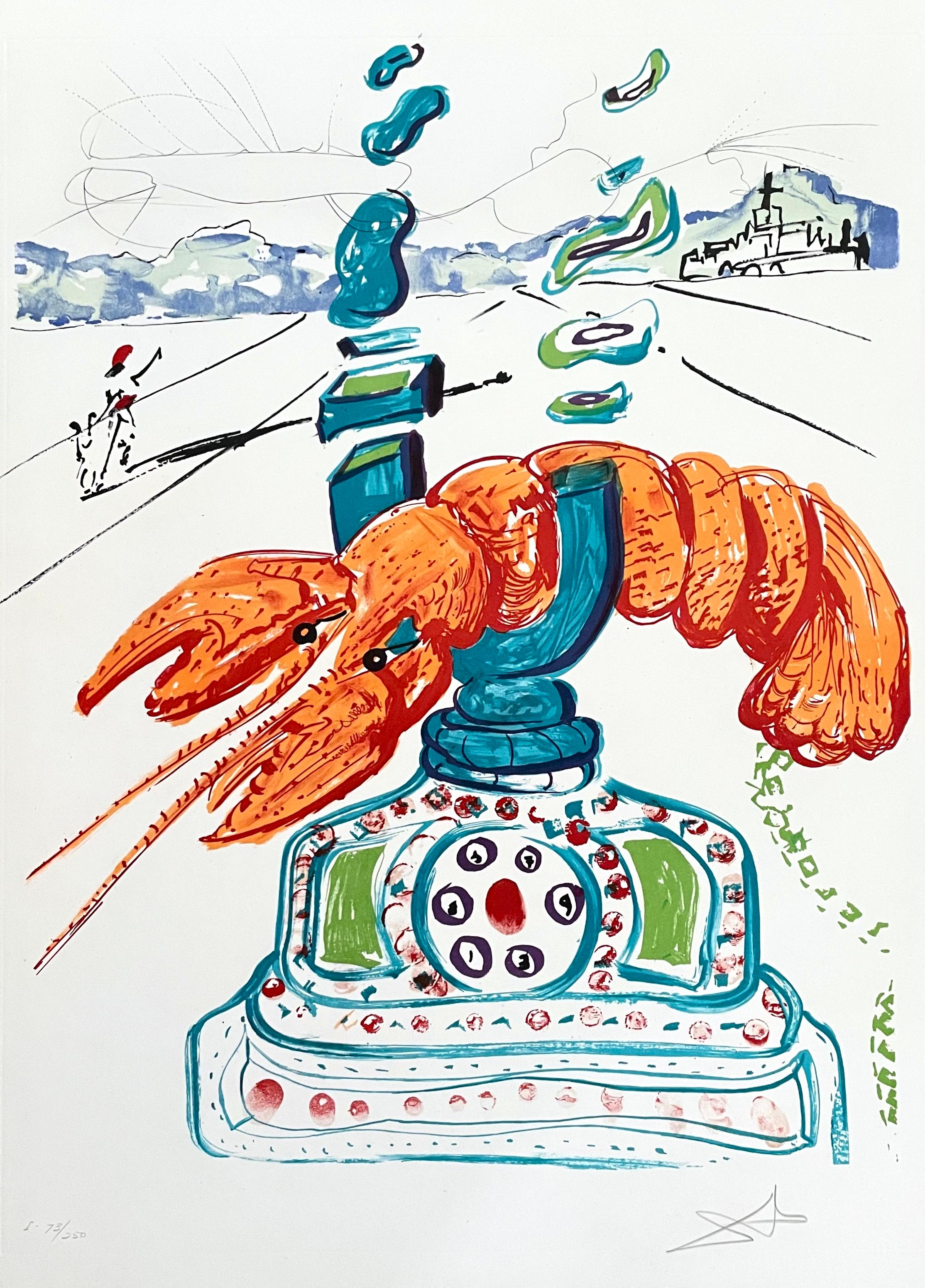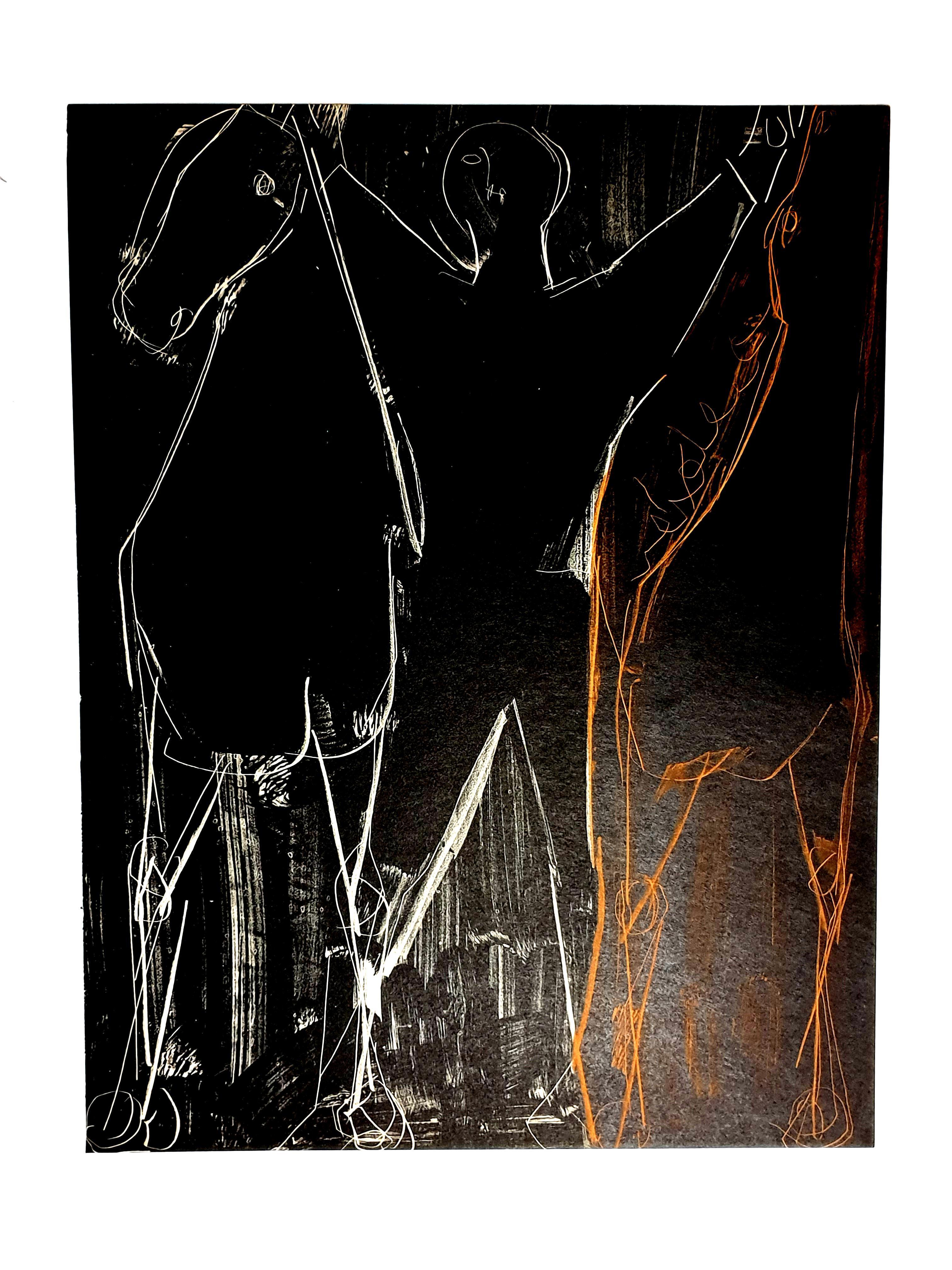Salvador DalíSalvador Dali signed coloured lithograph 'La Chimère d'Horace', 1970, 189/2501970
1970
About the Item
- Creator:Salvador Dalí (1904 - 1989, Spanish)
- Creation Year:1970
- Dimensions:Height: 28 in (71.12 cm)Width: 20 in (50.8 cm)Depth: 1 in (2.54 cm)
- Medium:
- Movement & Style:
- Period:
- Condition:In what appears to be in its original frame, unexamined out of frame to retain authenticity. Paper is slightly oxidised around edges. In a folded mount with a cream inner mount which has some foxing and would benefit replacement.
- Gallery Location:Petworth, GB
- Reference Number:1stDibs: LU540314104722
Salvador Dalí
Instantly recognizable by his waxed, upturned mustache, the flamboyant Salvador Dalí is one of modern art’s most distinctive figures. He is also one of the icons of the 20-century avant-garde Surrealist movement, whose dreamlike images, drawn from the depths of the unconscious, he deployed in paintings, sculptures, prints and fashion, as well as in film collaborations with Luis Buñuel and Alfred Hitchcock.
Dalí was born in Figueres, Catalonia, and even as a youngster, displayed the sensitivity, sharp perception and vivid imagination that would later define his artworks. In these, he conjured childhood memories and employed religious symbols and Freudian imagery like staircases, keys and dripping candles to create unexpected, often shocking pieces.
Dalí's use of hyperrealism in conveying Surrealist symbols and concepts that subvert accepted notions of reality is epitomized in what is perhaps his most recognizable painting, The Persistence of Memory (1931), in which he depicts the fluidity of time through melting clocks, their forms inspired by Camembert cheese melting in the sun. His artistic genius, eccentric personality and eternal quest for fame made him a global celebrity.
“Each morning when I awake, I experience again a supreme pleasure,” he once said. “That of being Salvador Dalí.”
Find original Salvador Dalí paintings, prints, sculptures and other works on 1stDibs.
- ShippingRetrieving quote...Ships From: Petworth, United Kingdom
- Return PolicyA return for this item may be initiated within 10 days of delivery.
- Salvador Dali signed lithograph 'Capricorn from the Zodiac II', 1975, `68/250By Salvador DalíLocated in Petworth, West SussexSalvador Dalí (Spanish, 1904-1989) Capricorn from The Zodiac II, 1975 Lithograph Signed and numbered `68/250 Dali’ (lower edge) 12.3/4 x 9.1/2 in. (32.4 x 24.2 cm.) Reference: Field ...Category
20th Century Surrealist Animal Prints
MaterialsLithograph
- Original early 20th Century German signed lithograph by Marcus BehmerBy Marcus BehmerLocated in Petworth, West SussexMarcus Behmer (German, 1879 – 1958) Die Geravbte orchidee (The robbed orchid), 1903 Signed ‘Marcus Behmer’ (lower right in pencil) Lithograph on paper 16.1/8 x 12in. (40.8 x 30.5cm.) It is apparent Behmer is influenced by the work of Aubrey Beardsley, though this work is no less beautiful in its execution. Little is known regarding his connections to Oscar Wilde though he is obviously an admirer and has many similarities with his private life and incarceration in prison. These works were a personal gift to Baron Detlev von Hadeln, the aristocrat and prominent art historian of the age. Behmer is known to be, since 1903, a member in the first ever homosexual organization in Berlin and was thus probably a part of Adolf Brand’s circle, and may have contributed to Brand’s publication Der Eigene. Until now, few know that Behmer was sentenced in April 1937 by a court in Konstanz to imprisonment for two years, being arrested in Freiburg and at other locations in southern Germany for being a homosexual. At times he was given the opportunity to work as an artist in prison. The works produced in this period are mostly calligraphic designed tablets with Greek text (prayers and Bible quotes...Category
Early 20th Century Art Nouveau More Prints
MaterialsLithograph
- 1960s printed vinyl copy of the 1938 original by Maurits Cornelis EscherLocated in Petworth, West SussexAfter Maurits Cornelis Escher (Dutch, 1898–1972) Sky and Water II Printed vinyl A 1960s copy of the 1938 original 21 x 17 in. (53.5 x 43 cm.) t...Category
20th Century Other Art Style Animal Prints
MaterialsEngraving
- 20th Century British cartoon woodblock print of angry cats by Rod NelsonLocated in Petworth, West SussexRod Nelson (British, 20th Century) Angry cats woodblock print signed and dated ‘Rod Nelson 1992’ (lower left) 7.1/4 x 7.5/8 in. (18.3 x 19.3 cm.)Category
20th Century Other Art Style Animal Prints
MaterialsWoodcut
- Signed surrealist lithograph by German artist Horst Antes, 1966- 68By Horst AntesLocated in Petworth, West SussexHorst Antes (German, 1936) Zwi Fusse (Two feet) Signed ‘Antes’ (lower right) and inscribed ‘profe’ (lower right) Executed in 1966 – 1968 Lithograph 22.3/4 x 28 in. (57.8 x 71.2 cm.) ...Category
20th Century Surrealist Abstract Prints
MaterialsLithograph
- 1970s Surrealist black and white etchings by German artist Christoph MuhilLocated in Petworth, West SussexChristoph Muhil (German, circa 1972) Die Kasten (links) Signed, inscribed and dated ‘C Muhil 1972’ and numbered ‘21/25’ (under the plate in pencil. Etching 11.3/4 x 9.3/4 in. (30 x...Category
20th Century Surrealist Abstract Prints
MaterialsEtching
- Cybernetic Lobster Telephone (Imagination & Objects), Salvador DaliBy Salvador DalíLocated in Fairfield, CTArtist: Salvador Dali (1904-1989) Title: Cybernetic Lobster Telephone (Imagination & Objects of the Future Portfolio) Year: 1975 Medium: Lithograph ...Category
1970s Surrealist Landscape Prints
MaterialsLithograph, Mixed Media
- Jean Arp - Original LithographBy Jean ArpLocated in Collonge Bellerive, Geneve, CHJean Arp - Original Lithograph 1951 Dimensions: 32 x 24 cm From the art revue XXe siècle Unsigned and unumbered as issuedCategory
1950s Surrealist Animal Prints
MaterialsLithograph
- Marino Marini - Horses - Original LithographBy Marino MariniLocated in Collonge Bellerive, Geneve, CHMarino Marini - Horses - Original Lithograph 1951 Dimensions: 32 x 24 cm From the art review XXe siècle Unsigned and unumbered as issuedCategory
1950s Surrealist Animal Prints
MaterialsLithograph
- Max Ernst - Elektra - LithographBy Max ErnstLocated in Collonge Bellerive, Geneve, CHMax Ernst - Elektra Lithograph 1939 Dimensions: 32 x 24 cm Signed in the plate From XXe siècle Unsigned and unumbered as issuedCategory
1930s Surrealist Animal Prints
MaterialsLithograph
- Max Ernst - Composition - Original LithographBy Max ErnstLocated in Collonge Bellerive, Geneve, CHMax Ernst - Composition - Original Lithograph 1958 Dimensions: 32 x 24 cm XXe siècle Unsigned and unnumbered, as issued Max Ernst was born in Bruhl, a place near Cologne, in Germany. He was raised in a strict Catholic family, and both of his parents were disciplinarians who were dedicated to training their children into God-fearing and talented individuals. Although his father was deaf, Ernst learned so much from him, particularly when it comes to painting. In fact, much of his early years were lived under the inspiration of his father who was also a teacher. He was the one who introduced painting to Ernst at an early age. In 1914, Ernst attended the University of Bonn where he studied philosophy. However, he eventually dropped out of school because he was more interested in the arts. He claimed that his primary sources of interest included anything that had something to do with painting. Moreover, he became fascinated with psychology, among other subjects in school. Primarily, Ernst's love for painting was the main reason why he became deeply interested with this craft and decided to pursue it later on in his life. During his early years, he became familiar with the works of some of the greatest artists of all time including Claude Monet, Paul Cezanne and Vincent van Gogh. He was also drawn to themes such as fantasy and dream imagery, which were among the common subjects of the works of Giorgio de Chirico. During World War I, Ernst was forced to join the German Army, and he became a part of the artillery division that exposed him greatly to the drama of warfare. A soldier in the War, Ernst emerged deeply traumatized and highly critical of western culture. These charged sentiments directly fed into his vision of the modern world as irrational, an idea that became the basis of his artwork. Ernst's artistic vision, along with his humor and verve come through strongly in his Dada and Surrealists works; Ernst was a pioneer of both movements. It was Ernst's memories of the war and his childhood that helps him create absurd, yet interesting scenes in his artworks. Soon, he took his passion for the arts seriously when he returned to Germany after the war. With Jean Arp, a poet and artist, Ernst formed a group for artists in Cologne. He also developed a close relationship with fellow artists in Paris who propagated Avant-Garde artworks. In 1919, Ernst started creating some of his first collages, where he made use of various materials including illustrated catalogs and some manuals that produced a somewhat futuristic image. His unique masterpieces allowed Ernst to create his very own world of dreams and fantasy, which eventually helped heal his personal issues and trauma. In addition to painting and creating collages, Ernst also edited some journals. He also made a few sculptures that were rather queer in appearance. In 1920s, influenced by the writings of psychologist Sigmund Freud, the literary, intellectual, and artistic movement called Surrealism sought a revolution against the constraints of the rational mind; and by extension, they saw the rules of a society as oppressive. Surrealism also embraces a Marxist ideology that demands an orthodox approach to history as a product of the material interaction of collective interests, and many renown Surrealism artists later on became 20th century Counterculture symbols such as Marxist Che Guevara. In 1922 Ernst moved to Paris, where the surrealists were gathering around Andre Breton. In 1923 Ernst finished Men Shall Know Nothing of This, known as the first Surrealist painting. Ernst was one of the first artists who apply The Interpretation of Dreams by Freud to investigate his deep psyche in order to explore the source of his own creativity. While turning inwards unto himself, Ernst was also tapping into the universal unconscious with its common dream imagery. Despite his strange styles, Ernst gained quite a reputation that earned him some followers throughout his life. He even helped shape the trend of American art during the mid-century, thanks to his brilliant and extraordinary ideas that were unlike those of other artists during his time. Ernst also became friends with Peggy Guggenheim, which inspired him to develop close ties with the abstract expressionists. When Ernst lived in Sedona, he became deeply fascinated with the Southwest Native American navajo art. In fact, the technique used in this artwork inspired him and paved the way for him to create paintings that depicted this style. Thus, Ernst became a main figure of this art technique, including the rituals and spiritual traditions included in this form of art. Pollock, aside from the other younger generations of abstract expressionists, was also inspired by sand painting of the Southwest...Category
1960s Surrealist Animal Prints
MaterialsLithograph
- Marino Marini - Rider - Original LithographBy Marino MariniLocated in Collonge Bellerive, Geneve, CHMarino Marini - Rider - Original Lithograph 1955 Dimensions: 32 x 24 cm From the art review XXe siècle Unsigned and unumbered as issuedCategory
1950s Surrealist Animal Prints
MaterialsLithograph






